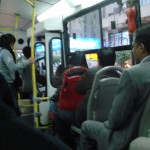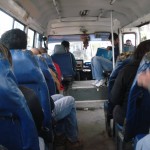Hello!
This is Ian Shay, a sophomore Spanish Major at Gustavus, writing from Lima, Perú. I’m here for a year with the CIEE Liberal Arts program, studying at the Pontificia Universidad Católica del Perú and staying with a host family. I arrived a couple weeks ago, and we are just finishing our Intensive Spanish in preparation for the normal semester on Monday. Now, prepare yourselves for the observations of a small-town Wisconsinite, fumbling for the first time in an urban transportation system. In Lima, the cheapest way to get around is on the micro.
Micros, whose name comes from microbus, I think, are actually buses ranging from small size to almost the size of a school bus. I take two micro rides each morning to get to school at the Católica. The fun thing about Lima is that there is no centralized map of all the micro routes. A bunch of private micro lines run throughout the city. It seems very confusing, but if you stick to major streets, and carry a bit of cash, you can pretty much always catch one going in your general direction. While I ride, I’ve taken to finger-tracing micro routes on my map of Lima, so I can develop an idea of where they go and a familiarity with the street layout. I feel a bit like a tourist with my map, though, but I guess I am a bit of a tourist.
One of the main characters of the micro is the cobrador(a), or the person who charges money. The name doesn’t do justice to their work. They simultaneously charge money, hand out tickets, advertise/shout their routes at 40 words a second, and shepherd passengers.
The micro routine is this:
1. Wait at a proper micro pickup location. This can be pretty much anywhere, as long as it’s a micro route. They pick people up at stop lights, stop signs, corners, pretty much anywhere. Every now and then, especially if the traffic is heavy (or if there’s been an illegal bus stop crackdown, perhaps? Who knows?), they will only stop at designated bus stops.
2. Wait for a micro that you know is going your way. This often requires some knowledge of the layout of Lima. When in doubt, ask the cobrador(a).
3. During the ride, the cobrador(a) will come around and take your money. Usually about one Sol (about 38 cents, last I checked). Hold onto your ticket as evidence of pay. Remind them where you’re getting off. They’re usually good about shouting reminders, but it’s also good to pay attention. When you’re near your stop, shout “baja [insert street/landmark].”
I remember one of my first micro rides, when my neighbor Meghan and I got on the micro without really understanding the cobrador very well, and didn’t really paying attention during the ride. The cobrador probably said “yeah, we’re going nearby the Católica,” which was true, since the street La Marina passes Avenida Universitaria. Well, we passed Universitaria, and got a little tour of the district of Callao, one of the furthest north in Lima.
The micro ride itself is pretty chill, once you get used to the lack of leg room, sometimes standing room only, the roar of the engine, frequent honking of horns, occasional proximity of less than 6 inches with other cars/buses, and motorcyclists who dart between lanes of cars. It works, they know what they’re doing. When I’m feeling daring, I even try to strike up conversations with people. It doesn’t always go anywhere, but every now and then you meet someone cool. Who needs cars in a place like this?
Peace,
Ian


